层次分析法---文献翻译
层次分析法模型外文文献翻译2014年译文2000字
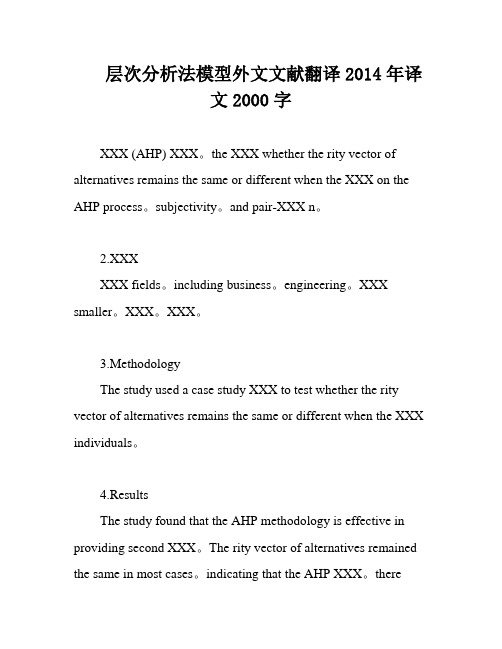
层次分析法模型外文文献翻译2014年译文2000字XXX (AHP) XXX。
the XXX whether the rity vector of alternatives remains the same or different when the XXX on the AHP process。
subjectivity。
and pair-XXX n。
2.XXXXXX fields。
including business。
engineering。
XXX smaller。
XXX。
XXX。
3.MethodologyThe study used a case study XXX to test whether the rity vector of alternatives remains the same or different when the XXX individuals。
4.ResultsThe study found that the AHP methodology is effective in providing second XXX。
The rity vector of alternatives remained the same in most cases。
indicating that the AHP XXX。
therewere some cases where the rity vector of alternatives differed。
suggesting that the AHP methodology is not XXX。
5.nThe results of the study suggest that the AHP methodologycan be an effective tool for improving n-making quality。
However。
it is XXX。
句子成分分析法和层次分析法
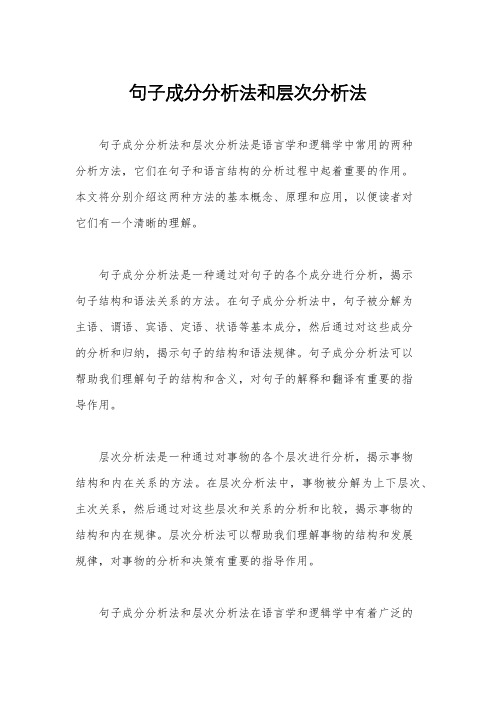
句子成分分析法和层次分析法句子成分分析法和层次分析法是语言学和逻辑学中常用的两种分析方法,它们在句子和语言结构的分析过程中起着重要的作用。
本文将分别介绍这两种方法的基本概念、原理和应用,以便读者对它们有一个清晰的理解。
句子成分分析法是一种通过对句子的各个成分进行分析,揭示句子结构和语法关系的方法。
在句子成分分析法中,句子被分解为主语、谓语、宾语、定语、状语等基本成分,然后通过对这些成分的分析和归纳,揭示句子的结构和语法规律。
句子成分分析法可以帮助我们理解句子的结构和含义,对句子的解释和翻译有重要的指导作用。
层次分析法是一种通过对事物的各个层次进行分析,揭示事物结构和内在关系的方法。
在层次分析法中,事物被分解为上下层次、主次关系,然后通过对这些层次和关系的分析和比较,揭示事物的结构和内在规律。
层次分析法可以帮助我们理解事物的结构和发展规律,对事物的分析和决策有重要的指导作用。
句子成分分析法和层次分析法在语言学和逻辑学中有着广泛的应用。
在语言学中,句子成分分析法可以帮助我们理解句子的结构和语法规律,对句子的解释、翻译和教学有重要的指导作用。
在逻辑学中,层次分析法可以帮助我们理解事物的结构和内在规律,对事物的分析、决策和规划有重要的指导作用。
句子成分分析法和层次分析法都是一种通过对事物进行分解和分析,揭示事物结构和规律的方法。
它们在不同领域有着广泛的应用,对我们理解事物、分析问题、决策规划都有着重要的指导作用。
因此,我们应该深入学习和掌握这两种方法,以便更好地应用它们解决实际问题。
同时,我们也应该不断总结和完善这两种方法,以适应不断变化的实际需求,为我们的工作和生活提供更好的支持和指导。
本科生毕业设计(论文)质量评价体系研究
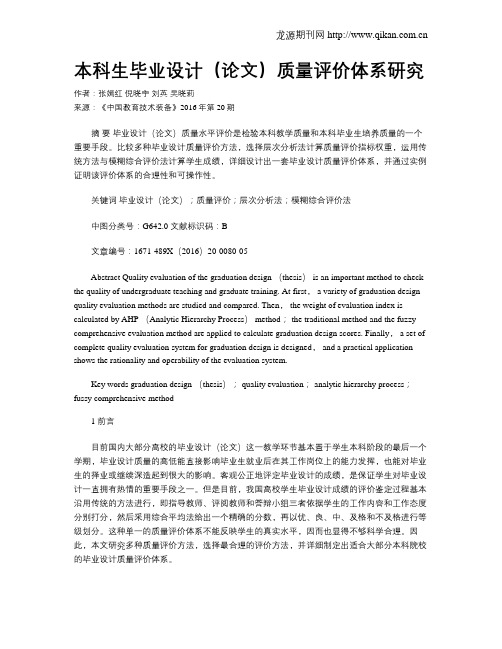
本科生毕业设计(论文)质量评价体系研究作者:张嫣红倪晓宇刘英吴晓莉来源:《中国教育技术装备》2016年第20期摘要毕业设计(论文)质量水平评价是检验本科教学质量和本科毕业生培养质量的一个重要手段。
比较多种毕业设计质量评价方法,选择层次分析法计算质量评价指标权重,运用传统方法与模糊综合评价法计算学生成绩,详细设计出一套毕业设计质量评价体系,并通过实例证明该评价体系的合理性和可操作性。
关键词毕业设计(论文);质量评价;层次分析法;模糊综合评价法中图分类号:G642.0 文献标识码:B文章编号:1671-489X(2016)20-0080-05Abstract Quality evaluation of the graduation design (thesis) is an important method to check the quality of undergraduate teaching and graduate training. At first, a variety of graduation design quality evaluation methods are studied and compared. Then, the weight of evaluation index is calculated by AHP (Analytic Hierarchy Process) method; the traditional method and the fuzzy comprehensive evaluation method are applied to calculate graduation design scores. Finally, a set of complete quality evaluation system for graduation design is designed, and a practical application shows the rationality and operability of the evaluation system.Key words graduation design (thesis); quality evaluation; analytic hierarchy process;fussy comprehensive method1 前言目前国内大部分高校的毕业设计(论文)这一教学环节基本置于学生本科阶段的最后一个学期,毕业设计质量的高低能直接影响毕业生就业后在其工作岗位上的能力发挥,也能对毕业生的择业或继续深造起到很大的影响。
从语域分析的角度看英汉翻译

第19卷第4期 佛山科学技术学院学报(社会科学版) Vol.19No.4 2001年10月 Jo urnal of Fo shan University(Social Science)Oct.2001文章编号:1008-018X(2001)04-0041-05从语域分析的角度看英汉翻译巩湘红(中山大学外语学院,广东广州510275)摘要:运用语言学的理论来解决翻译的问题是当代翻译理论的一个特点。
奈达的“动态对等”翻译标准便是将现代语言学的最新研究成果应用到翻译理论中而提出的。
语域分析作为语言学中的一个重要组成部分无疑是“动态对等”论必须考虑的问题。
关键词:动态对等;语域分析;翻译中图分类号:H315.9 文献标识码:A当代西方翻译理论的一个特点就是运用语言学的理论来解决翻译的问题。
比如美国当代著名的语言学家和翻译理论家尤金・奈达对现代翻译理论研究领域的重要功绩之一就是把现代语言学的最新研究成果应用到了翻译理论当中,结合信息论和符号学的知识提出了“动态对等”的翻译标准。
在他的定义中,“所谓翻译就是在译入语中用最贴切的自然的对等语把原语中的信息复制过来,首先是在含义方面,其次是文体风格”(周仪、罗平,1998)。
他的“动态对等”论用一句话就是“译文对译文接受者所起的作用,应与原文对原文接受者所起的作用大体相等。
”为了达到这一效果,奈达提出了四个原则:(1)忠实于原文的内容;(2)译文与原文的文学体裁所起的作用一致;(3)读者对译文的接受程度;(4)译文将用于什么样的环境(周仪、罗平,1998)。
奈达的这四个原则使人们很容易想起现代语言学中对语言语域的划分,语域分析自然也是探讨奈达的这一“动态对等”论必须充分考虑的问题。
本文就将从这一角度结合实例来证明语域分析是实现等效翻译所不可忽视的因素。
何谓语域(Reg ister)关于语域的定义,不同的语言学家并未达成一致,但大多数语言学家一致认为语域是指语言随着使用场合或环境的不同而区分的变体。
AHP层次分析法--实例
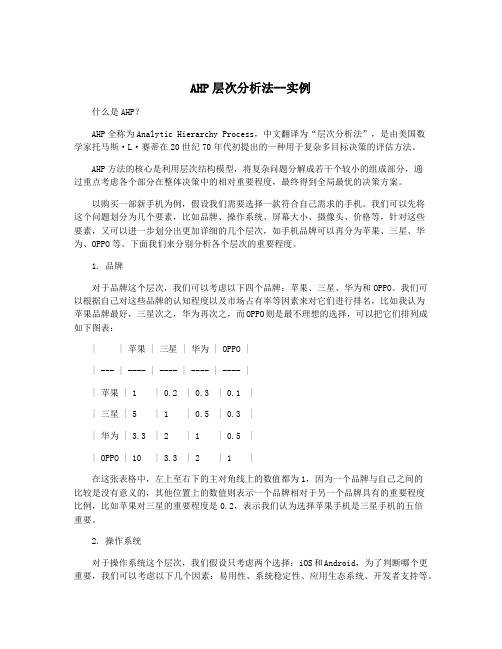
AHP层次分析法--实例什么是AHP?AHP全称为Analytic Hierarchy Process,中文翻译为“层次分析法”,是由美国数学家托马斯·L·赛蒂在20世纪70年代初提出的一种用于复杂多目标决策的评估方法。
AHP方法的核心是利用层次结构模型,将复杂问题分解成若干个较小的组成部分,通过重点考虑各个部分在整体决策中的相对重要程度,最终得到全局最优的决策方案。
以购买一部新手机为例,假设我们需要选择一款符合自己需求的手机。
我们可以先将这个问题划分为几个要素,比如品牌、操作系统、屏幕大小、摄像头、价格等,针对这些要素,又可以进一步划分出更加详细的几个层次,如手机品牌可以再分为苹果、三星、华为、OPPO等。
下面我们来分别分析各个层次的重要程度。
1. 品牌对于品牌这个层次,我们可以考虑以下四个品牌:苹果、三星、华为和OPPO。
我们可以根据自己对这些品牌的认知程度以及市场占有率等因素来对它们进行排名,比如我认为苹果品牌最好,三星次之,华为再次之,而OPPO则是最不理想的选择,可以把它们排列成如下图表:| | 苹果 | 三星 | 华为 | OPPO || --- | ---- | ---- | ---- | ---- || 苹果 | 1 | 0.2 | 0.3 | 0.1 || 三星 | 5 | 1 | 0.5 | 0.3 || 华为 | 3.3 | 2 | 1 | 0.5 || OPPO | 10 | 3.3 | 2 | 1 |在这张表格中,左上至右下的主对角线上的数值都为1,因为一个品牌与自己之间的比较是没有意义的,其他位置上的数值则表示一个品牌相对于另一个品牌具有的重要程度比例,比如苹果对三星的重要程度是0.2,表示我们认为选择苹果手机是三星手机的五倍重要。
2. 操作系统对于操作系统这个层次,我们假设只考虑两个选择:iOS和Android,为了判断哪个更重要,我们可以考虑以下几个因素:易用性、系统稳定性、应用生态系统、开发者支持等。
翻译硕士名词解释词条
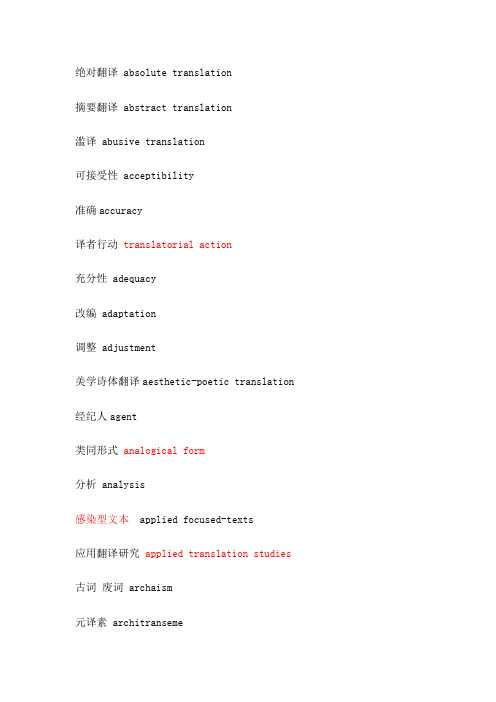
绝对翻译 absolute translation摘要翻译 abstract translation滥译 abusive translation可接受性 acceptibility准确accuracy译者行动translatorial action充分性 adequacy改编 adaptation调整 adjustment美学诗体翻译aesthetic-poetic translation 经纪人agent类同形式analogical form分析 analysis感染型文本 applied focused-texts应用翻译研究applied translation studies 古词废词 archaism元译素 architranseme范围的翻译理论area-restricted theories of translation 听觉媒介型文本 audio-medial texts委托 commission自动翻译 automatic translation自立幅度 autonomy spectrum自译 autotranslation逆转换 back-transformation范围的翻译理论back-translation双边传译 bilateral interpreting双语语料库bilingual corporal双文本bi-text空位 blank spaces无韵体翻译 blank verse translation借用 borrowing仿造 calque机助翻译 MAT范畴转换 category shift词类转换 class shift贴近翻译 close translation连贯 coherence委托 commission传意负荷 communication load传意翻译 communicative translation社群传译 community interpreting对换 commutation可比语料库 comparable corpora补偿compensation能力 competence成分分析componential analysis机器辅助翻译MAT一致性concordance会议传译conference interpreting接续传译consecutive interpreting建构性翻译常规 constitutive translational conventions派生内容的形式content-derivative form重内容文本 content-focused texts语境一致contextual consistency受控语言 controlled language常规 conventions语料库 corpora可修正性 correctability对应 correspondence法庭传译court interpreting隐型翻译covert translation跨时翻译理论 cross-temporal theories of translation 文化途径 cultural approach文化借用 cultural borrowing文化替换 cultural substitution文化翻译 cultural translation文化移植 cultural transplantation文化置换 cultural transposition区分度degree of differentiation翻译定义definitions of translation描写翻译研究 descriptive translation studies图表翻译diagrammatic translation对话传译 dialogue interpreting说教忠信didactic fidelity直接翻译 direct translation翻译方向 direction of translation消解歧义disambiguation话语类型的翻译理论discourse type-restricted theories of translation文献型翻译 documentary translation归化翻译 domesticating translation配音 dubbing动态性 dynamics动态对等 dynamic equivalence动态忠信 dynamic fidelity用功模式 effort models借用 borrowing种族学翻译enthnographic translation翻译的种族语言学模式 enthnolinguistic model of translation 非目标接受者 excluded receiver诠释性翻译 exegetic translation诠释忠信 exegetical fidelity异国情调 exoticism期望规范 expectancy norms明示 explicitation表情型文本 expressive texts外部转移external transfer外来形式 extraneous form忠实faithfulness假朋友false friends假翻译fictitious translation贴近 coherence异化翻译 foreignizing translation派生形式的形式 form-derivative forms重形式文本 content-focused texts形式对应 formal correspondence形式对等 formal equivalence前向转换 forward transformation自由译 free translation全文翻译 total translation功能取向翻译研究 function-oriented translation studies 功能对等 function equivalence空隙 gaps宽泛化 generalization宽泛化翻译generalizing translation要旨翻译gist translation释词翻译 gloss translation成功 success目的语 goal languages语法分析 grammatical analysis语法置换 grammatical transposition字形翻译graphological translation诠释步骤 hermeneutic motion对应层级hierarchy of correspondences历史忠信historical fidelity同音翻译homophonic translation音素翻译phonemic translation横向翻译 horizontal translation超额信息 hyperinformation同一性identity地道翻译idomatic translation地道性idomaticity不确定性indeterminacy间接翻译 indirect translation翻译即产业过程 translation as industrial process 信息负荷 information load信息提供 information offer信息型文本informative texts初始规范initial norms工具型翻译 instrumental translation整合翻译 integral translation跨文化合作intercultural cooperation中间语言 interlanguage隔行翻译interlineal translation逐行翻译interlinear translation语际语言 interlingua语际翻译interlingual translation中介翻译 intermediate translation内部转移 internal transfer解释 interpretation传译 interpreting翻译释意理论 interpretive theory of translation 符际翻译intersemiotic translation互时翻译intertemporal translation 语内翻译intralingual translation 系统内转换 intra-system shift不变量 invariant不变性 invariance逆向翻译inverse translation隐形 invisibility核心 kernel关键词翻译 keyword translation贴近 coherence可核实性 verifiability可修正性 correctability空缺 voids层次转换 level shift词汇翻译 lexical translation联络传译 liaison interpreting普遍语言 lingua universalis语言学途径linguistic approach语言对等 linguistic equivalence语言翻译linguistic translation语言创造性翻译linguistically creative translation 字面翻译 literal translation直译法 literalism借译 load translation原素logeme逻各斯 logos低地国家学派 low countries groups忠诚 loyalty机助翻译MAT机器翻译machine translation操纵manipulation操纵学派manipulation school图谱mapping矩阵规范matricial norms中继翻译 mediated translation中介语言 mediating language词译 metaphrase元诗metapoem元文本 metatext韵律翻译metrical translation模仿形式mimetic form最小最大原则 minimax principle 小众化 minoritizing translation 调整 modification调适 modulation语义消歧 semantic disambiguation 多语语料库multilingual corpora 多媒介型文本multi-medial texts 多阶段翻译 multiple-stage texts 变异 mutation自然性 naturalness必要区分度 necessary degree of differentiation 负面转换negative shift无遗留原则no leftover principle规范 norms必要对等语 obligatory equivalents曲径翻译 oblique translation观察型接受者observational receiver信息提供 information offer操作模式operational models操作规范 operational norms运作型文本 operative texts可换对等语 optional equivalents有机形式organic form重合翻译 overlapping translation显型翻译 overt translation范式对等 paradigmatic equivalence平行语料库 parallel corpora释词 paraphrase局部翻译理论 partial theories of translation 部分重合翻译partially-overlapping translation 参与型接受者particularizing receiver具体化翻译 particularizing translation赞助 patronage运用 performance音素翻译phonemic translation音位翻译phonological translation中枢语言 pivot language译诗为文poetry into prose争辩式翻译polemical translation多元系统理论 polysystem theory译后编辑 post-editing译前编辑pre-editing语用途径 pragmatic approach精确度 degree of precision预先规范preliminary norms规定翻译研究 prescriptive theories of translation首级翻译 primary translation问题的翻译理论 problem-restrained theories of translation 成品取向翻译研究 product-oriented studies of translation 过程取向翻译研究 process-oriented studies of translation 专业规范 professional norms散文翻译 prose translation前瞻式翻译prospective translation抗议 protest原型文本 prototext伪翻译 psedotranslation公共服务传译 public service interpreting纯语言 pure language原始翻译 radical translation级阶受限翻译rank-bound translation级阶的翻译理论 rank-restricted theories of translation读者取向机器翻译 reader-oriented machine translation 独有特征 realia接受语 receptor language重构式翻译translation with reconstructions冗余 redundancy折射refraction规约性翻译常规 regulative translational conventions 转接传译 relay interpreting知识库要素repertoreme变换措词rephrasing阻抗 resistancy受限翻译 restricted translation重组 restructuring转译 retranslation后瞻式翻译retrospective translation换词rewording换声 revoicing重写 rewrtiting韵体翻译rhymed translation翻译科学 science of translation目的论scopos theory二级翻译second-hand translation二手翻译secondary translation选译 selective translation自译 self translation语义消歧 semantic disambiguation语义翻译 semantic translation语义空缺 semantic voids意义理论theory of sense意对意翻译 sense-for-sense translation 序列翻译 serial translation服务翻译 service translation转换shifts视译 sight translation手语传译signed language translation同声传译simultaneous interpreting源语 source language源文本source text源文本取向翻译研究source text-oriented translation studies 具体化specification结构转换 structure shift文体对等 stylistic equivalence子语言sublanguage配字幕 substituting成功 success超额翻译 overtranslation组合对等syntagmatic equivalence系统system有声思维记录think-aloud protocols目标语 target language目标文本 target texts目标文本取向翻译研究 target text-oriented translation studies 术语库 term banks术语 terminology文本类型学text typology文本素texteme文本类型的翻译理论 text type-restricted theories of translation 文本对等 textual equivalence文本规范 textual norms理论翻译研究theoretical translation studies意义理论theory of sense增量翻译 thick translation有声思维记录 think aloud protocols第三语码third code第三语言third language时域的翻译理论 temporal-restricted theories of translation完全翻译 total translation巴别塔 tower of babel注音 transcription译素 transeme转移 transfer转移取向翻译研究 transfer-oriented translation studies 迁移 transference转换 transformation可译性 translatability笔译 translation翻译与博弈理论 translation and the theory of games翻译即抉择translation as decision-making翻译即产业过程 translation as industrial process翻译对等translation equivalence翻译研究translation studies翻译理论translation theory翻译单位 translation unit翻译普遍特征translation universals重构式翻译 translation with reconstructions翻译对等 translation equivalence 翻译体 translationese翻译学translatology译者行动translatorial action音译 transliteration符际转化 transmutation置换 transposition不受限翻译 unbounded translation 欠额翻译 undertranslation翻译单位 translation unit单位转换 unit shift不可译性 untranslatability词语一致verbal consistency可核实性 correctability改本改译 version纵向翻译vertical translation空缺 voids耳语传译whispered interpreting词对词翻译 word- for-word translation作者取向翻译机器 reader-oriented machine translation。
谈谈英汉互译中常用的翻译方法_孙良诚
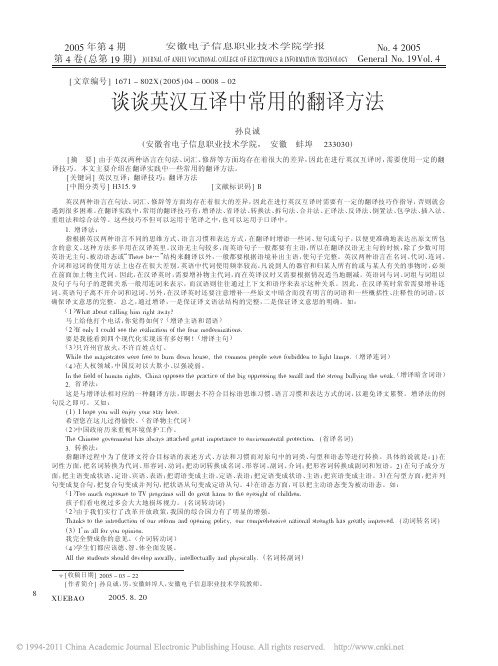
谈谈英汉互译中常用的翻译方法
孙良诚 0 1
, 摘 要 - 由于英汉两种语言在句法、 词汇、 修辞等方面均存在着很大的差异, 因此在进行英汉互译时, 需要使用一定的翻 译技巧。本文主要介绍在翻译实践中一些常用的翻译方法。 , 关键词 - 英汉互译;翻译技巧;翻译方法 , 中图分类号 - 2/3)4 5 , 文献标识码 - $
英汉两种语言在句法、 词汇、 修辞等方面均存在着很大的差异, 因此在进行英汉互译时需要有一定的翻译技巧作指导, 否则就会 遇到很多困难。 在翻译实践中, 常用的翻译技巧有: 增译法、 省译法、 转换法、 拆句法、 合并法、 正译法、 反译法、 倒置法、 包孕法、 插入法、 重组法和综合法等。这些技巧不但可以运用于笔译之中, 也可以运用于口译中。 34 增译法: 指根据英汉两种语言不同的思维方式、 语言习惯和表达方式, 在翻译时增添一些词、 短句或句子, 以便更准确地表达出原文所包 含的意义。 这种方法多半用在汉译英里。 汉语无主句较多, 而英语句子一般都要有主语, 所以在翻译汉语无主句的时候, 除了少数可用 “ 67898 :8… ” 英语无主句、 被动语态或 结构来翻译以外, 一般都要根据语境补出主语, 使句子完整。英汉两种语言在名词、 代词、 连词、 介词和冠词的使用方法上也存在很大差别。 英语中代词使用频率较高, 凡说到人的器官和归某人所有的或与某人有关的事物时, 必须 在前面加上物主代词。因此, 在汉译英时, 需要增补物主代词, 而在英译汉时又需要根据情况适当地删减。英语词与词、 词组与词组以 及句子与句子的逻辑关系一般用连词来表示,而汉语则往往通过上下文和语序来表示这种关系。因此,在汉译英时常常需要增补连 词。 英语句子离不开介词和冠词。 另外, 在汉译英时还要注意增补一些原文中暗含而没有明言的词语和一些概括性、 注释性的词语, 以 确保译文意思的完整。总之, 通过增译, 一是保证译文语法结构的完整, 二是保证译文意思的明确。如: ( 3) ;7<= <:>?= @<AABCD 7BE 9BD7= <F<GH ( 增译主语和谓语 ) 马上给他打个电话, 你觉得如何? (’ ) IJ >CAG I @>?AK L88 =78 98<ABM<=B>C >J =78 J>?9 E>K89CBM<=B>CL4 (增译主句 ) 要是我能看到四个现代化实现该有多好啊! (/ ) 只许州官放火, 不许百姓点灯。 ;7BA8 =78 E<DBL=9<=8L F898 J988 => :?9C K>FC 7>?L8N =78 @>EE>C O8>OA8 F898 J>9:BKK8C => ABD7= A<EOL4 ( 增译连词 ) (P ) 在人权领域, 中国反对以大欺小、 以强凌弱。 IC =78 JB8AK >J 7?E<C 9BD7=LN Q7BC< >OO>L8L =78 O9<@=B@8 >J =78 :BD >OO98LLBCD =78 LE<AA <CK =78 L=9>CD :?AAGBCD =78 F8<R4(增译暗含词语 ) ’4 省译法: 这是与增译法相对应的一种翻译方法, 即删去不符合目标语思维习惯、 语言习惯和表达方式的词, 以避免译文累赘。增译法的例 句反之即可。又如: 0 3 1 I 7>O8 G>? FBAA 8CS>G G>?9 L=<G 78984 (省译物主代词 ) 希望您在这儿过得愉快。 (’ ) 中国政府历来重视环境保护工作。 678 Q7BC8L8 D>T89CE8C= 7<L <AF<GL <==<@78K D98<= BEO>9=<C@8 => 8CTB9>CE8C=<A O9>=8@=B>C4 0 省译名词 1 /4 转换法: 指翻译过程中为了使译文符合目标语的表述方式、 方法和习惯而对原句中的词类、 句型和语态等进行转换。具体的说就是: 31在 词性方面, 把名词转换为代词、 形容词、 动词; 把动词转换成名词、 形容词、 副词、 介词; 把形容词转换成副词和短语。 ’ 1 在句子成分方 面, 把主语变成状语、 定语、 宾语、 表语; 把谓语变成主语、 定语、 表语; 把定语变成状语、 主语; 把宾语变成主语。 / 1 在句型方面, 把并列 句变成复合句, 把复合句变成并列句, 把状语从句变成定语从句。 P 1 在语态方面, 可以把主动语态变为被动语态。如: (3 ) 6>> E?@7 8UO>L?98 => 6V O9>D9<EL FBAA K> D98<= 7<9E => =78 8G8LBD7= >J @7BAK98C4 孩子们看电视过多会大大地损坏视力。 0 名词转动词 1 (’ ) 由于我们实行了改革开放政策, 我国的综合国力有了明显的增强。 67<CRL => =78 BC=9>K?@=B>C >J >?9 98J>9E <CK >O8CBCD O>AB@GN >?9 @>EO9878CLBT8 C<=B>C<A L=98CD=7 7<L D98<=AG BEO9>T8K4 0 动词转名词 1 0 / 1 I W E <AA J>9 G>? >OBCB>C4 (介词转动词 ) 我完全赞成你的意见。 (P ) 学生们都应该德、 智、 体全面发展。 %AA =78 L=?K8C=L L7>?AK K8T8A>O E>9<AAGN BC=8AA8@=?<AAG <CK O7GLB@<AAG4 0 名词转副词 1
汉译英:段落层次的分析语翻译实践 (1)

3
•
• • •
英语语篇的衔接
• I tried to get to sleep. My neighbour owns an acoustic guitar and an electric guitar. He likes to play the electric guitar. I had to get up at the crack of dawn for work the next day. The other neighbour and his wife must be more tolerant than me. I don't know what his other neighbour thinks about it. I don't know what his wife thinks about it. My neighbour plays the guitar quite badly. I wish my neighbour would take up another hobby. • I'm trying to get to sleep but he's at it again, my neighbour, playing the guitar. He actually owns two guitars, a simple acoustic one and an expensive electric one. But he seems to prefer to play the electric one late at night when I'm trying to get to sleep and have to get up at the crack of dawn for work the next day. I don't know what his other neighbour thinks about it, or his wife for that matter. They must be more tolerant than me. The problem is, not only does he play the guitar very loudly, but he also plays it quite badly. I really wish he would take up another hobby altogether, or at least find a quieter musical instrument to play.
- 1、下载文档前请自行甄别文档内容的完整性,平台不提供额外的编辑、内容补充、找答案等附加服务。
- 2、"仅部分预览"的文档,不可在线预览部分如存在完整性等问题,可反馈申请退款(可完整预览的文档不适用该条件!)。
- 3、如文档侵犯您的权益,请联系客服反馈,我们会尽快为您处理(人工客服工作时间:9:00-18:30)。
层次分析法---文献翻译888大学毕业设计(论文)文献翻译题目层次分析法院、系(部) 计算机科学与技术学院专业及班级计科0903班姓名 888 指导教师 888 日期 2013年3月Analytic Hierarchy ProcessThe Analytic Hierarchy Process (AHP) is a structured technique for helpingpeople deal with complex decisions. Rather than prescribing a "correct" decision, the AHP helps people to determine one that suits their needs and wants. Based on mathematics and psychology, it was developed by Thomas L. Saaty in the 1970s and has been extensively studied and refined since then. The AHP provides a comprehensive and rational framework for structuring a problem, for representing and quantifying its elements, for relating those elements to overall goals, and for evaluating alternative solutions. It is used throughout the world in a wide variety of decision situations, in fields such as government, business, industry, healthcare, and education.Several firms supply computer software to assist in using the process.Users of the AHP first decompose their decision problem into a hierarchy of more easily comprehended sub-problems, each of which can be analyzed independently. The elements of the hierarchy can relate to anyaspect of the decision problem—tangible or intangible, carefully measured or roughly estimated, well- or poorly-understood—anything at all that applies to the decision at hand.Once the hierarchy is built, the decision makers systematically evaluate its various elements, comparing them to one another in pairs. In making the comparisons, the decision makers can use concrete data about the elements, or they can use their judgments about the elements' relative meaning and importance. It is the essence of the AHP that human judgments, and not just the underlying information, can be used in performing the evaluations.The AHP converts these evaluations to numerical values that can be processed and compared over the entire range of the problem. A numerical weight or priority is derived for each element of the hierarchy, allowing diverse and often incommensurable elements to be compared to one another in a rational and consistent way. This capability distinguishes the AHP from other decision making techniques.In the final step of the process, numerical priorities are derivedfor each of the decision alternatives. Since these numbers represent the alternatives' relative ability to achieve the decision goal, they allow a straightforward consideration of the various courses of action.Uses and applicationsWhile it can be used by individuals working on straightforward decisions, Analytic Hierarchy Process (AHP) is most useful where teamsof people are working on complex problems, especially those with high stakes, involving human perceptionsand judgments, whose resolutions have long-term repercussions. Ithas unique advantages where important elements of the decision are difficult to quantify or compare, or where communication among team members is impeded by their different specializations, terminologies, or perspectives.Decision situations to which the AHP can be applied include:, Choice - The selection of one alternative from a given set of alternatives,usually where there are multiple decision criteria involved., Ranking - Putting a set of alternatives in order from most toleastdesirable Prioritization - Determining the relative merit of a setofalternatives, as opposed to selecting a single one or merely ranking them, Resource allocation - Apportioning resources among a set of alternatives, Benchmarking - Comparing the processes in one's own organization withthose of other best-of-breed organizations, Qualitymanagement - Dealing with the multidimensional aspects of quality and quality improvementThe applications of AHP to complex decision situations have numbered in the thousands, and have produced extensive results in problems involving planning, Resource allocation, priority setting, and selection among alternatives. Other areas have included forecasting, toreotal quality management, business process re-engineering ,quality function deployment, and the Balanced Scorecard.ManyAHP applications are never reported to the world at large, because they take place at high levels of large organizations where security and privacy considerations prohibit their disclosure. But some uses of AHP are discussed in the literature. Recently thesehave included:, Deciding how best to reduce the impact of global climate change (Fondazione Eni Enrico Mattei), Quantifying the overall quality of software system(Microsoftcorporation), Selecting university faculty(Bloomsburg University of Pennsy), Deciding where to locate offshore manufacturing plants(University ofCambridge), Assessing risk in operating cross-country prtroleumpipelines(AmericanSociety of Civil Engineers), Deciding how best to manage U.S. watersheds(U.S. Department of Agriculture)AHP is sometimes used in designing highly specific procedures for particular situations, such as the rating of buildings by historic significance. It was recently applied to a project that uses video footage to assess the condition of highways inVirginia. Highway engineers first used it to determine the optimum scope of the project, then to justify its budget to lawmakers.AHP is widely used in countries around the world. At a recent international conference on AHP, over 90 papers were presented from 19 countries, including the U.S., Germany, Japan, Chile , Malaysia, andNepal. Topics covered ranged from Establishing Payment Standards for Surgical Specialists, to Strategic TechnologyRoadmapping, to Infrastructure Reconstruction in Devastated Countries. AHP wasintroduced in China in 1982, and its use in that country has expanded greatly since then—its methods are highly compatible with the traditional Chinese decision making framework, and it has been used for many decisions in the fieldsofeconomics,energy,management,environment,traffic,agriculture, industry, and the military.Though using AHP requires no specialized academic trainning, the subject is widely taught at the university level—one AHP software provider lists over a hundredcolleges and universities among its clients. AHP is considered an important subject in many institutions of higher learning, includingschools of engineering and Graduate school of Business . AHP is also an important subject in the quality field, and is taught in many specialized courses including Six Sigma, Lean Six Sigma, and QFD.In China, nearly a hundred schools offer courses in AHP, and many doctoral students choose AHP as the subject of their research and dissertations. Over 900 papers have been published on the subject inthat country, and there is at least one Chinese scholarly journal devoted exclusively to AHP.ImplementationAs can be seen in the examples that follow, using the AHP involves the mathematical synthesis of numerous judgments about the decision problem at hand. It is not uncommon for these judgments to number in the dozens or even the hundreds. While the math can be done by hand or with a calculator, it is far more common to use one of several computerized methods for entering and synthesizing the judgments. The simplest of these involve standard spreadsheet software, while the most complex use custom software, often augmented by special devices for acquiring the judgmentsof decision makers gathered in a meeting room.Steps in using the processThe procedure for using the AHP can be summarized as:1. Model the problem as a hierarchy containing the decision goal,the alternativesfor reaching it, and the criteria for evaluating the alternatives.2. Establish priorities among the elements of the hierarchy bymaking a series ofjudgments based on pairwise comparisons of the elements. For example, whencomparing potential real-estate purchases, the investors might say they preferlocation over price and price over timing.3. Synthesize these judgments to yield a set of overall prioritiesfor the hierarchy.This would combine the investors' judgments about location, priceand timingfor properties A, B, C, and D into overall priorities for each property.4. Check the consistency of the judgments.5. Come to a final decision based on the results of this process.CriticismsThe AHP is now included in most operations research and management science textbooks, and is taught in numerous universities; it is used extensively in organizations that have carefully investigated its theoretical underpinnings. While the general consensus is that it isboth technically valid and practically useful, the method does have its critics.In the early 1990s a series of debates between critics andproponents of AHP was published in Management Science and The Journal of the Operational ResearchSociety. These debates seem to have been settled in favor of AHP.Occasional criticisms still appear. A 1997 paper examined possible flaws in the verbal (vs. numerical) scale often used in AHP pairwise comparisons. Another from the same year claimed that innocuous changesto the AHP model can introduce order where no order exists. A 2006 paper found that the addition of criteria for which all alternatives perform equally can alter the priorities of alternatives. An in-depth paper discussing the academic criticisms of AHP was published in Operations Research in2001.Most of the criticisms involve a phenomenon called rank reversal, discussed inthe following section.Rank reversalMany people hear about rank reversal and assume that there is some sort of proven principle about it that needs to be upheld in making decisions. That assumption has led to much misunderstanding of AHP and other decision making techniques. In actuality, rank reversal is a complex matter about which there are many conflicting ideas and opinions. This section offers a simplified explanation of the situation.Decision making involves ranking alternatives in terms of criteriaor attributes of those alternatives. It is an axiom of some decision theories that when new alternatives are added to a decision problem, the ranking of the old alternatives must not change. But in the real world, adding new alternatives can change the rank of the old ones. These rank reversals do not occur often, but the possibility of their occurrencehassubstantial logical implications about the methodology used to make decisions, the underlying assumptions of various decision theories, etc.A simple example will demonstrate the phenomenon of rank reversal: Consider a pretty girl in a small town. She's having a party next week, and she wants to buy a dress that will impress her guests. She visitsthe town's only dress store and goes to the rack of party dresses. There are five such dresses, and after long consideration she ranks them by desirability as follows:Rank Style Color Price1 Style A Blue $1092 Style A Green $1093 Style B Red $1194 Style C Yellow $995 Style D Off-White $149Now imagine that she enters the back room and sees the store'sentire inventory of dresses. The dresses she has looked at in Styles B, C, and D are the only ones of their kind, but there are four more StyleA dresses in green and eight more Style A dresses in blue. In the language of decision science, these dresses are copies of the existing alternatives. In our one-store small town scenario, there's a reasonable chance that one or more party guests would buy and wear one of the copies.When made aware of these new alternatives, our fashion-consciousgirl might rank her choices in a different order. Considering her great embarrassment if a guest were to wear the same dress that she did, she might rank her choices like this:OldRank Style Color PriceRank1 3 Style B Red $1192 4 Style C Yellow $993 5 Style D Off-White $1494 2 Style A Green $1095 1 Style A Blue $109Notice that the rankings of the two Style A dresses have reversed (since there are more copies of the blue dress than of the green one). Not only that, but Style A has gone from the most preferred style to the least preferred. Rank reversal has occurred. Axioms of decision theories have been violated. Scholars and researchers can cry"foul," or impugn the method by which the girl has made her choice, but there is no denying that in the world of our example, ranks havebeen reversed. There is no doubt that the reversal is due to the introduction of additional alternatives that are no different from the existing ones.The above is but one example of rank reversal. Rank reversal canalso occur when additional alternatives are added/removed that are not copies of the original alternatives (e.g., red and yellow dresses in completely different styles). Another example of rank reversal occurred in the 2000 U.S. presidential election. Ralph Nader was an 'irrelevant' alternative, in that he was dominated by both the Democrat and Republican candidates. However, since he attracted more votes from those who would have voted Democrat rather than Republican, his presence caused the ranks to reverse. Put another way, if Nader were not in the race, it is widely accepted that Al Gore would have won.There are two schools of thought about rank reversal. One maintains that new alternatives that introduce no additional attributes should not cause rank reversal under any circumstances. The other maintains that there are both situations in which rank reversal is not reasonable as well as situations where they are to be expected. The current version of the AHP can accommodate both these schools — its Ideal Mode preserves rank, while its Distributive Mode allows the ranks to change. Either mode is selected according to the problem at hand.层次分析法层次分析法(AHP)是一种帮助人们处理复杂决策的结构化技术,比起一种指定的“正确”的方法,层次分析法能帮助人们决定哪一种是更适合他们的需求。
